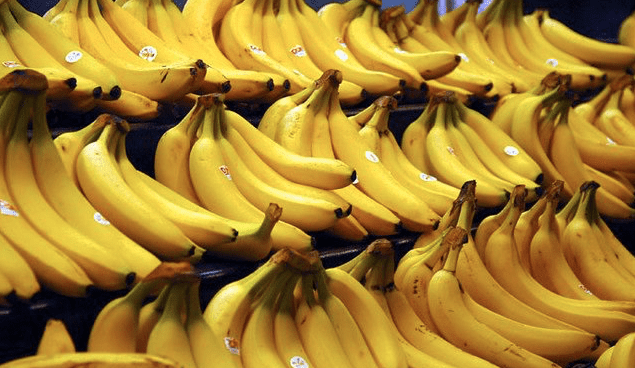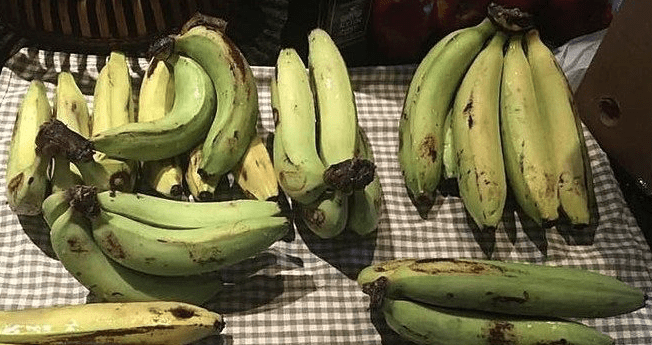Elizabeth Ruda
Chicago, Illinois, United States

The average person does not go to the grocery store, look around the produce section, and think, “Wow, these foods could be extinct within the next few years.” Yet extinction is possible in the case of the most common cultivar of banana sold today, the Cavendish.1 At the same time humans (and some animals) grapple with the infectious disease that is COVID-19,2 twenty-first-century bananas are likewise plagued by the fungus that nearly eradicated another cultivar some seventy years before.
Gros Michel (“Big Mike”)
In the early-to-mid 1900s, the Gros Michel cultivar of banana, commonly translated as “Big Mike” or “Fat Mike,” accounted for the majority of banana exports.3 The cultivar is genetically akin to the Cavendish, resulting in a similar, and to some, superior taste, but bears a thicker peel and is more resistant to bruising than its “two-third” sibling.4,5,6 Both cultivars are seedless and are reproduced asexually—as a result, the vast majority of bananas then and now are genetic clones.7

Though worldwide trade obscures its origin, the Gros Michel is believed to be native to Myanmar, Thailand, Malaysia, Indonesia, and Sri Lanka.8 The banana industry itself is said to have been established by French botanist Jean Francois Pouyat’s introduction of the Gros Michel to Jamaica from Martinique circa 1835, a move possibly intended to add diversity to his coffee estate.9 From there, the Gros Michel was free to rise to overwhelming popularity as an export in the early 1880s, reigning over the global banana market as the preferred cultivar of shippers and dealers.10
The Gros Michel was not, however, free from disease and death.

Panama disease
Fusarium oxysporum f. sp cubense is a soil-borne fungus that causes “Panama disease,” also known as “Fusarium wilt,” in banana plants. It is believed to have originated from south and southeast Asia and was first reported in Australia in 1876.11,12 The name “Panama disease” may seem unfitting, but stems from an outbreak in Panama’s Bocas del Toro region.13 Transmission occurs through infected soil, especially that picked up on the shoes of workers or the tires of vehicles, or by replantation.14 The disease rises through plants’ roots and stifles access to water and nutrients.15
Fusarium wilt is considered “undoubtedly one of the most destructive plant diseases in modern times,” in the words of Randy C. Ploetz, professor of plant pathology at the University of Florida.16 Its notoriety as a destructive force comes from its devastation of the Gros Michel shortly after the cultivar’s dominance of the market. Almost every banana plantation across the globe became infected with the disease.17 From 1940–1960 in the Ulua Valley of Honduras alone, writes Ploetz, 30,000 hectares (over 74,000 acres or almost 116 square miles) of Gros Michel bananas were consumed by Fusarium wilt.18 The susceptibility of the cultivar to Fusarium wilt stems from its asexual reproduction. What affects the immune system of one banana plant will surely affect the plant’s genetic clone.
At the time, the cost of establishing a single hectare of plantation ran between $2,000 and $5,000. With so many plantations relying on the Gros Michel for income, direct losses were in the millions.19 Records of losses related to Fusarium wilt largely do not account for the impact on local banana consumption, which includes cultivars beyond the Gros Michel or Cavendish and made up approximately 85% of banana production in 2000.20 Losses in this sector are presumed “significant.” Such dramatic devastation forced the banana industry’s hand.
Cavendish
The Cavendish banana, like the Gros Michel, is considered a dessert banana, as opposed to a plantain, or cooking banana.21 It is currently the most common cultivar imported in countries outside of tropical regions, though about 85% of banana cultivation around the world is made up of plantain varieties.22 Originally from China and less sturdy than the Gros Michel, it was forced into the mainstream when found to be resistant to Fusarium wilt.23 Its similarity to the Gros Michel was enough to win over the public—a United Fruit Company executive is even quoted as saying the two cultivars were close enough to “fool most people.”24 Since then, the Cavendish has enjoyed market dominance as a monoculture like its all-but-forgotten sibling before it.
The Cavendish’s dominance is not the end of the story, as history may repeat itself. The cultivar is not immune to Fusarium wilt, but it is susceptible to a particular strain: Fusarium oxysporum f. sp cubense Tropical Race 4 (Foc TR4). The strain that affected the Gros Michel is referred to as Tropical Race 1. TR4 was first found in 1989 in Taiwan, then in southeast Asia, Australia, Israel, Lebanon, and India, and most recently in Colombia in 2019.25 As 99% of all exported bananas in 2019 were Cavendish, almost all coming from Latin America, the transmission of TR4 to Colombia raises considerable concern for the economies of the countries and communities that produce the Cavendish, along with the future of the cultivar itself.26
Panama disease prevention
The Food and Agriculture Organization of the United Nations finds little can be done to fight Fusarium wilt once discovered to have infected a crop.27 Current methods of prevention are limited to containment of affected areas, while crossbreeding and genetic engineering look to create a type of banana resistant to disease.28 This unique type would also need to be able to travel long distances, avoid bruising, and taste good for optimal market performance. More time and testing are required before a “new” banana could be brought to market, though agroecologists and regenerative farmers say to bring back the “old.” Restoring genetic biodiversity by varying the cultivars of bananas produced and brought to market will be more sustainable (and natural) than current methods of production.29
Not only bananas, but apples, corn (maize), coffee, vanilla, wheat, avocados, and oysters suffer from a lack of biodiversity, struggling to survive disease outbreaks and severe weather events.30 Natural diversity among food varieties allows one variety to continue growing where another was wiped out, but limiting foods to monocultures can leave people reliant on a singular crop at economic and nutritional risk.31
Fusarium wilt’s threat to the Cavendish is only a symptom of a larger issue: monocultures have weak “immune systems.” In order for economies, diets, and ecosystems to remain intact, the structure of how we grow food must be redeveloped, and the average consumer’s recognition of what it means to buy an apple, ear of corn, or banana must adapt.
End notes
- “Cultivar” and “variety” are often used interchangeably. For distinctions between the two, please see: https://huskerhort.com/2014/04/06/variety-cultivar-hybrid-heirloom-what-terms-mean/
- “Animals and COVID-19,” Centers for Disease Control and Prevention, April 27, 2022, https://www.cdc.gov/coronavirus/2019-ncov/daily-life-coping/animals.html.
- Randy C. Ploetz, “Panama Disease: A Classic and Destructive Disease of Banana,” Plant Health Progress 1, no. 1 (December 4, 2000), https://doi.org/10.1094/php-2000-1204-01-hm.
- Anne Vézina, “Gros Michel or Cavendish, Which Is the Yummiest Banana?” ProMusa, December 13, 2018, https://www.promusa.org/blogpost579-Gros-Michel-or-Cavendish-which-is-the-yummiest-banana.
- Dan Koeppel, “Yes, We Will Have No Bananas,” The New York Times, June 18, 2008, https://www.nytimes.com/2008/06/18/opinion/18koeppel.html. Archived at https://web.archive.org/web/20140302053643/https://www.nytimes.com/2008/06/18/opinion/18koeppel.html.
- Anne Vézina et al., “Gros Michel,” ProMusa, July 23, 2020, https://www.promusa.org/Gros+Michel.
- Encyclopaedia Britannica, “Banana,” accessed April 27, 2022, https://www.britannica.com/plant/banana-plant.
- Douglas H. Marin, Turner B. Sutton, and Kenneth R. Barker, “Dissemination of Bananas in Latin America and the Caribbean and Its Relationship to the Occurrence of Radophouls similis,” Plant Disease 82, no. 9 (1998): 964–974, doi:10.1094/PDIS.1998.82.9.964.
- Marin, Sutton, and Barker, “Dissemination of Bananas.”; Robert John Lancashire, “Jamaican bananas and plantains,” University of the West Indies, November 17, 2013, http://wwwchem.uwimona.edu.jm/lectures/banana.html.
- John Soluri, Banana Cultures: Agriculture, Consumption, and Environmental Change in Honduras and the United States, (University of Texas Press, 2005), 336, https://utpress.utexas.edu/books/solban. Quoted in Vézina, “Gros Michel or Cavendish?”
- Randy Ploetz and Kenneth Pegg, abstract, “Fusarium wilt of banana and Wallace’s line: Was the disease originally restricted to his Indo-Malayan region?” Australasian Plant Pathology 26 (1997): 239–249, https://doi.org/10.1071/AP97039.
- “The Problem,” Panama Disease, Wageningen University & Research, November 22, 2017, https://fusariumwilt.org/index.php/en/the-problem/#what-is-panama-disease.
- Steve Marquardt, “‘Green Havoc’: Panama Disease, Environmental Change, and Labor Process in the Central American Banana Industry,” The American Historical Review 106, no. 1 (2001): 49, http://dx.doi.org/10.2307/2652224.
- Matt Reynolds, “A Fungus Could Wipe out the Banana Forever,” Wired, Conde Nast, August 19, 2019, https://www.wired.com/story/fungus-could-wipe-out-banana-forever/.
- Reynolds, “A Fungus.”
- Randy C. Ploetz, “Panama Disease: A Classic and Destructive Disease of Banana,” Plant Health Progress 1, no. 1 (December 4, 2000), p. 2, https://doi.org/10.1094/php-2000-1204-01-hm.
- Reynolds, “A Fungus.”
- Ploetz, “Panama Disease,” 2.
- Ploetz, “Panama Disease,” 2.
- Ploetz, “Panama Disease,” 2.
- Encyclopaedia Britannica, “Banana.”
- Encyclopaedia Britannica, “Banana.”
- Koeppel, “Yes, We Will Have No Bananas.”
- Vézina, “Gros Michel or Cavendish?”
- Reynolds, “A Fungus.”
- Reynolds, “A Fungus.”
- “Banana Facts and Figures,” Food and Agriculture Organization of the United Nations, accessed April 27, 2022, https://www.fao.org/economic/est/est-commodities/oilcrops/bananas/bananafacts/en/.
- Reynolds, “A Fungus.”
- Nina Lakhani et al., “Our Food System Isn’t Ready for the Climate Crisis,” The Guardian, April 19, 2022, https://www.theguardian.com/food/ng-interactive/2022/apr/14/climate-crisis-food-systems-not-ready-biodiversity.
- Nina Lakhani et al., “Our Food System.”
- Nina Lakhani et al., “Our Food System.”
Bibliography
- “Animals and COVID-19.” Centers for Disease Control and Prevention, April 27, 2022. https://www.cdc.gov/coronavirus/2019-ncov/daily-life-coping/animals.html.
- “Banana Facts and Figures.” Food and Agriculture Organization of the United Nations. Accessed April 27, 2022. https://www.fao.org/economic/est/est-commodities/oilcrops/bananas/bananafacts/en/.
- Encyclopaedia Britannica. “Banana.” Accessed April 27, 2022. https://www.britannica.com/plant/banana-plant.
- Koeppel, Dan. “Yes, We Will Have No Bananas.” The New York Times, June 18, 2008. https://www.nytimes.com/2008/06/18/opinion/18koeppel.html. Archived at https://web.archive.org/web/20140302053643/https://www.nytimes.com/2008/06/18/opinion/18koeppel.html.
- Lakhani, Nina, Alvin Chang, Rita Liu, and Andrew Witherspoon. “Our Food System Isn’t Ready for the Climate Crisis.” The Guardian, April 19, 2022. https://www.theguardian.com/food/ng-interactive/2022/apr/14/climate-crisis-food-systems-not-ready-biodiversity.
- Lancashire, Robert John. “Jamaican bananas and plantains.” University of the West Indies, November 17, 2013. http://wwwchem.uwimona.edu.jm/lectures/banana.html.
- Marin, Douglas H., Turner B. Sutton, and Kenneth R. Barker. “Dissemination of Bananas in Latin America and the Caribbean and its Relationship to the Occurrence of Radophouls similis.” Plant Disease 82, no. 9 (1998): 964–974. doi:10.1094/PDIS.1998.82.9.964.
- Marquardt, Steve. “‘Green Havoc’: Panama Disease, Environmental Change, and Labor Process in the Central American Banana Industry.” The American Historical Review 106, no. 1 (2001): 49. http://dx.doi.org/10.2307/2652224.
- “The Problem.” Panama Disease. Wageningen University & Research, November 22, 2017. https://fusariumwilt.org/index.php/en/the-problem/#what-is-panama-disease.
- Ploetz, Randy C. “Panama Disease: A Classic and Destructive Disease of Banana.” Plant Health Progress 1, no. 1 (December 4, 2000). https://doi.org/10.1094/php-2000-1204-01-hm.
- Ploetz, Randy, and Kenneth Pegg. “Fusarium wilt of banana and Wallace’s line: Was the disease originally restricted to his Indo-Malayan region?” Australasian Plant Pathology 26 (1997): 239–249. https://doi.org/10.1071/AP97039.
- Reynolds, Matt. “A Fungus Could Wipe out the Banana Forever.” Wired. Conde Nast, August 19, 2019. https://www.wired.com/story/fungus-could-wipe-out-banana-forever/.
- Soluri, John. Banana Cultures: Agriculture, Consumption, and Environmental Change in Honduras and the United States. (University of Texas Press, 2005) 336. https://utpress.utexas.edu/books/solban. Quoted in Vézina, Anne. “Gros Michel or Cavendish, Which is the Yummiest Banana?” ProMusa, December 13, 2018. https://www.promusa.org/blogpost579-Gros-Michel-or-Cavendish-which-is-the-yummiest-banana.
- Vézina, Anne. “Gros Michel or Cavendish, which is the yummiest banana?” ProMusa, December 13, 2018. https://www.promusa.org/blogpost579-Gros-Michel-or-Cavendish-which-is-the-yummiest-banana.
- Vézina, Anne, System Administrator, Inge Van den Bergh, Rhiannon Crichton, and Max Ruas. “Gros Michel.” ProMusa, July 23, 2020. https://www.promusa.org/Gros+Michel.
ELIZABETH RUDA is the Assistant Editor of Hektoen International. She graduated summa cum laude with a BA in English in 2021.
Highlighted in Frontispiece Volume 14, Issue 3 – Summer 2022

Leave a Reply